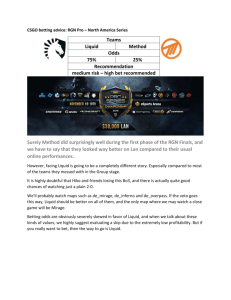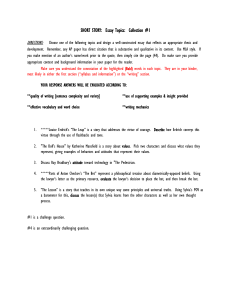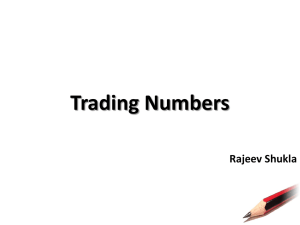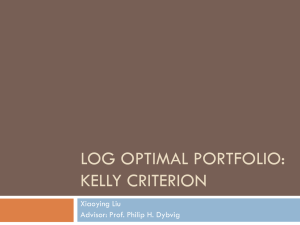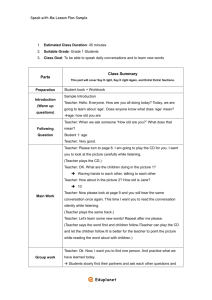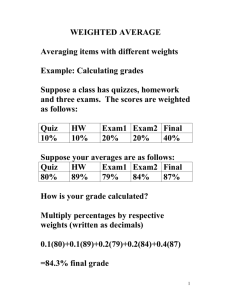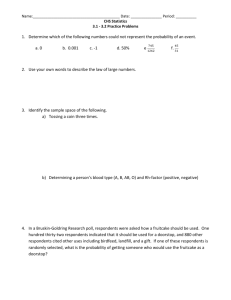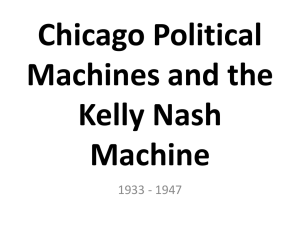Generalizing the Kelly Criterion Formulated by John L. Kelly and
advertisement
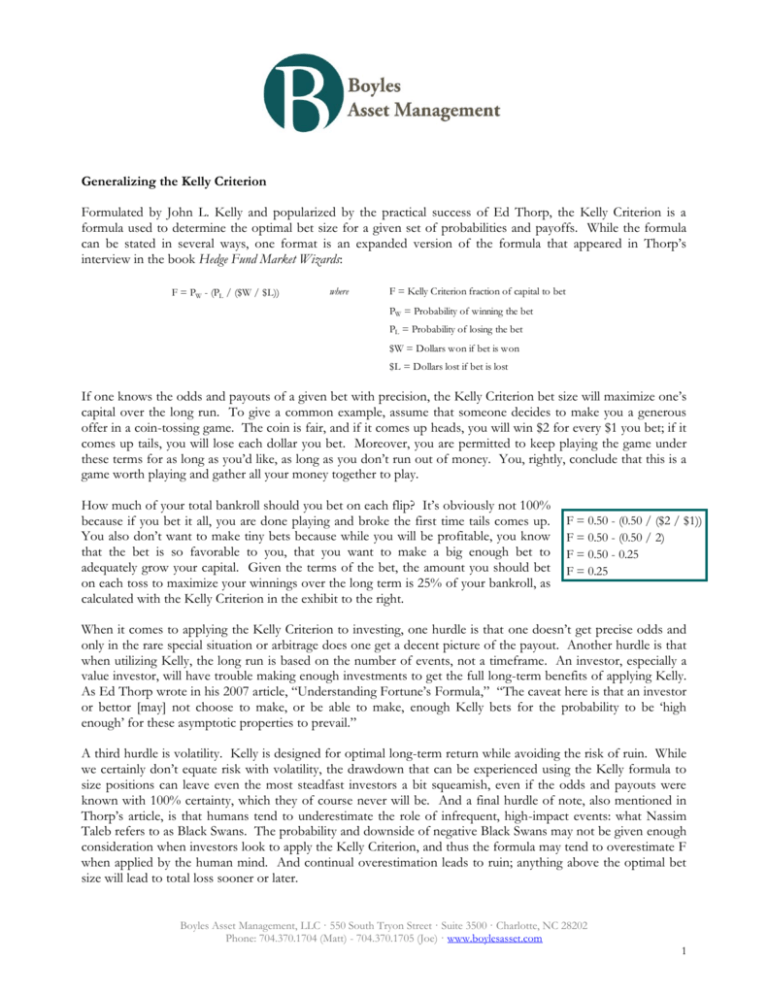
Generalizing the Kelly Criterion Formulated by John L. Kelly and popularized by the practical success of Ed Thorp, the Kelly Criterion is a formula used to determine the optimal bet size for a given set of probabilities and payoffs. While the formula can be stated in several ways, one format is an expanded version of the formula that appeared in Thorp’s interview in the book Hedge Fund Market Wizards: F = PW - (PL / ($W / $L)) where F = Kelly Criterion fraction of capital to bet PW = Probability of winning the bet PL = Probability of losing the bet $W = Dollars won if bet is won $L = Dollars lost if bet is lost If one knows the odds and payouts of a given bet with precision, the Kelly Criterion bet size will maximize one’s capital over the long run. To give a common example, assume that someone decides to make you a generous offer in a coin-tossing game. The coin is fair, and if it comes up heads, you will win $2 for every $1 you bet; if it comes up tails, you will lose each dollar you bet. Moreover, you are permitted to keep playing the game under these terms for as long as you’d like, as long as you don’t run out of money. You, rightly, conclude that this is a game worth playing and gather all your money together to play. How much of your total bankroll should you bet on each flip? It’s obviously not 100% because if you bet it all, you are done playing and broke the first time tails comes up. You also don’t want to make tiny bets because while you will be profitable, you know that the bet is so favorable to you, that you want to make a big enough bet to adequately grow your capital. Given the terms of the bet, the amount you should bet on each toss to maximize your winnings over the long term is 25% of your bankroll, as calculated with the Kelly Criterion in the exhibit to the right. F = 0.50 - (0.50 / ($2 / $1)) F = 0.50 - (0.50 / 2) F = 0.50 - 0.25 F = 0.25 When it comes to applying the Kelly Criterion to investing, one hurdle is that one doesn’t get precise odds and only in the rare special situation or arbitrage does one get a decent picture of the payout. Another hurdle is that when utilizing Kelly, the long run is based on the number of events, not a timeframe. An investor, especially a value investor, will have trouble making enough investments to get the full long-term benefits of applying Kelly. As Ed Thorp wrote in his 2007 article, “Understanding Fortune’s Formula,” “The caveat here is that an investor or bettor [may] not choose to make, or be able to make, enough Kelly bets for the probability to be ‘high enough’ for these asymptotic properties to prevail.” A third hurdle is volatility. Kelly is designed for optimal long-term return while avoiding the risk of ruin. While we certainly don’t equate risk with volatility, the drawdown that can be experienced using the Kelly formula to size positions can leave even the most steadfast investors a bit squeamish, even if the odds and payouts were known with 100% certainty, which they of course never will be. And a final hurdle of note, also mentioned in Thorp’s article, is that humans tend to underestimate the role of infrequent, high-impact events: what Nassim Taleb refers to as Black Swans. The probability and downside of negative Black Swans may not be given enough consideration when investors look to apply the Kelly Criterion, and thus the formula may tend to overestimate F when applied by the human mind. And continual overestimation leads to ruin; anything above the optimal bet size will lead to total loss sooner or later. Boyles Asset Management, LLC · 550 South Tryon Street · Suite 3500 · Charlotte, NC 28202 Phone: 704.370.1704 (Matt) - 704.370.1705 (Joe) · www.boylesasset.com 1 But despite the difficulties and hurdles in its application to investing, the logic behind the Kelly Criterion can be useful in thinking about whether or not to establish a position in a given situation and, if one is to be established, what proportion of one’s capital should be invested in the position. First, let’s consider one truth in the formula: If PW > PL AND $W > $L, then the bet or investment is worth making, at least before considering other alternatives (more on this in a bit). If both the odds and the payout are in your favor, then the expected return is positive and so the position/bet size given by the Kelly Criterion will be greater than zero. While the formula doesn’t require both PW > PL and $W > $L, generally focusing on ideas that meet both of those metrics can give one an extra margin of safety, and in general, that’s what most value investors seem to do. Before moving on, let’s expand a couple of definitions to make them friendlier to investing vocabulary: $W = Dollars Won if Bet is Won = Your Estimate of Intrinsic Value $L = Dollars Lost if Bet is Lost = What You Lose in Worst-Case Scenario Estimating intrinsic value based on cash flows, private market values, and liquidation values is something that should be familiar to those that follow a value philosophy; as is considering one’s downside in a worst-case scenario. And because these are estimates—and small changes in certain variables can have large impacts on expected values—it’s important to be conservative in those estimates. Or to use a phrase from Seth Klarman, it’s important to make those estimates “by compounding multiple conservative assumptions.” Things start to get tricky when it comes to estimating probabilities, which one can’t really do with any degree of accuracy. It is too hard and too close to guesswork, especially when we consider that, according to Sir John Templeton, “No security analyst is ever going to be right more than two-thirds of the time.” So if we can’t accurately estimate our probability of winning and losing, what can we do? What we believe an investor can do is determine whether or not the odds are likely to be in one’s favor. There are certain things that can increase one’s chance of not losing money on an investment, and certain things that increase the chance of losing should something unexpected or disruptive occur. In Nassim Taleb’s book, Antifragile, he separates things into three categories: 1) Fragile 2) Robust 3) Antifragile The fragile is harmed by certain shocks, randomness, and stressors. The robust is neither harmed nor helped by them. And the antifragile grows and improves from them. As Taleb says, “...the idea is to focus on fragility rather than predicting and calculating future probabilities…” So while we can’t accurately predict probabilities, what we can do is think about and identify traits that will increase our chances of winning and decrease our chances of losing under a range of scenarios. And by trying to avoid fragile traits and invest in situations that are more robust or, preferably, antifragile, we decrease our chances of making mistakes due to estimation error. Below are some examples of these traits among businesses and investments: Boyles Asset Management, LLC · 550 South Tryon Street · Suite 3500 · Charlotte, NC 28202 Phone: 704.370.1704 (Matt) - 704.370.1705 (Joe) · www.boylesasset.com 2 Increases PW or, Increases Robustness / Antifragility Increases PL or, Increases Fragility Conservative balance sheet Debt/leveraged balance sheet Management with high stock ownership Management with low stock ownership, or mostly options instead of stock Management that understands capital allocation (repurchases shares and makes acquisitions only at attractive prices) Management that spends money just for the sake of doing something Competitive advantage / moat Competitive disadvantage / no moat Tangible asset value protection Paying a high price for growth Buying shares from distressed or uninformed sellers Buying shares when management or other informed investors are selling Flexibility Rigidness Ability to raise prices, especially in response to inflation Difficulty passing rising costs on to customers “...the fragile wants tranquility, the antifragile grows from disorder, and the robust doesn’t care too much.” –Nassim Taleb When the positive traits overwhelm the negative traits, we can be fairly confident that the odds are in our favor. But figuring out which traits are really present and which are illusory takes a lot of work; as does coming up with a proper and conservative estimate of intrinsic value and a worst-case scenario. The math behind the Kelly Criterion gives a good framework for thinking about the questions: (1) Is my probability of winning greater than my probability of losing?; and (2) Is my upside greater than my downside? But there is a lot of work that needs to be done in order to answer those questions with decent accuracy. “It’s not supposed to be easy. Anyone who finds it easy is stupid.” –Charlie Munger Using the Kelly framework to explain our current outlook on the investment climate, we can say that we see plenty of things with attractive upside ($W), but the main issue is that we also think there is plenty of downside ($L) in those investments. To optimize one’s capital over time, one should consider more than just the upside if things go right. One must be in the game long enough for the odds to work out favorably over time. The main reason we have so much cash today is that we see a lot of downside coupled amongst the upside. We look for situations where, if we ran through the Kelly Criterion using conservative assumptions, it would tell us to take large position sizes. Our actual position sizes will, in practice, be much smaller than Kelly, as we manage risk and account for the uncertainties and errors that come with investing. But the idea behind taking big positions in one’s best ideas—especially when one’s downside is well protected—is one in which we firmly believe. In the Ed Thorp article mentioned earlier, he also wrote that “Computing [F] without the context of the available alternative investments is one of the most common oversights I’ve seen in the use of the Kelly Criterion. Because it generally overestimates [F] it is a dangerous error.” And as we contemplate our alternatives to cash, we think not just about the current opportunity set, but also about opportunities that may possibly develop over the next several months. We’ve been and are still close to buying several things; and we continue to build our list of prospects. While we can’t know when Mr. Market will give us the opportunity to put our cash to work, we are ready to move in quickly when we think the odds and payouts are overwhelmingly in our favor. Boyles Asset Management, LLC · 550 South Tryon Street · Suite 3500 · Charlotte, NC 28202 Phone: 704.370.1704 (Matt) - 704.370.1705 (Joe) · www.boylesasset.com 3
